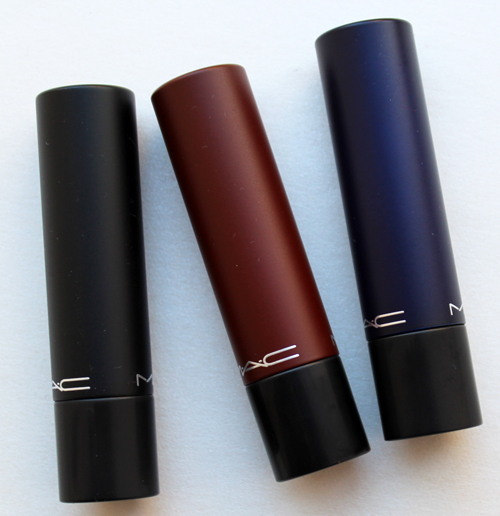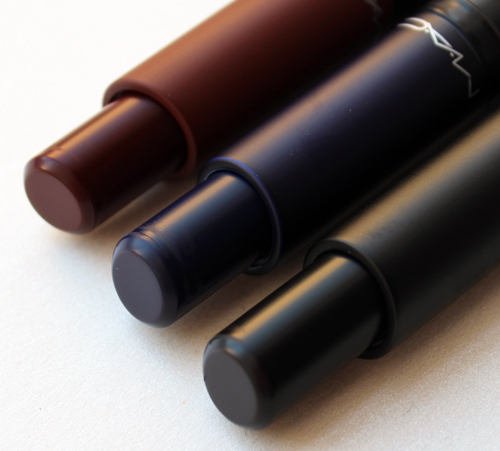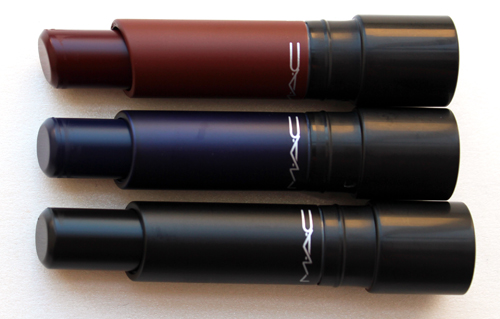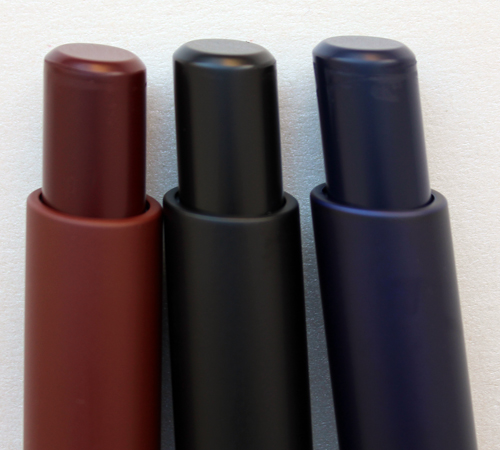As soon as I saw the word "tetrachromat" in the various descriptions of MAC's Liptensity lipsticks, I knew I'd have to investigate. MAC's new range was created in partnership with a tetrachromat, someone with the very unique genetic ability to see up to 100 million different colors (us boring old trichromats can only see 1 million, boo). Working with a tetrachromat allowed the company to produce "the most technologically advanced lip product to date" using "high-frequency tetrachromatic pigments technology" or at least, that's what MAC's telling us. The bigwigs weigh in: “It’s a tech story; it’s not a fun, frivolous collection were doing,” James Gager, senior vice president and group creative director of M.A.C., said. “It is super, super saturated, undeniable color load in this lipstick.” Adds Jennifer Balbier, senior vice president, global product development at MAC Cosmetics, “Liptensity contains pre-saturated pigment combined with a clear base — unlike most lipstick bases that are more opaque or 'muddier' — to give a 'true' color. When people say that the ‘color stays true,’ it’s not always true because it acts with your own chemistry.” Sounds impressive, but is it for real? Let's look into this a little further to see whether the world's first makeup based on tetrachromacy is really all that superior to what's currently out there or if it's just the emperor's new clothes.
First though, what causes tetrachromacy and how exactly does it work? According to this article, a tetrachromat has 4 different types of cone cells, i.e., the receptor cells that recognize color. The 3 usual cones that most humans have are attuned to wavelengths of red, green and blue (almost like a TV), while the special 4th cone detects yellow. Not only that, scientists have discovered that to be a true tetrachromat, one not only requires the extra 4th cone, but their brains must also be able to distinguish it from the other cones. In other words, some people have 4 types of cones but since their brains are wired like trichromats, it doesn't register any additional colors. It's possible that by retraining the neural pathways to detect more colors, people with 4 cones may eventually achieve true tetrachromacy. As vision scientist Jay Nietz told Discover Magazine, 'Most of the things that we see as colored are manufactured by people who are trying to make colors that work for trichromats…It could be that our whole world is tuned to the world of the trichromat.' Furthermore, "[Nietz] also suspects the natural world may not have enough variation in color for the brain to learn to use a fourth cone. Tetrachromats might never need to draw on their full capacity. They may be trapped in a world tailored to creatures with lesser powers. Perhaps if these women regularly visited a lab where they had to learn—really learn—to tell extremely subtle shades apart, they would awaken in themselves the latent abilities of their fourth cone. Then they could begin to see things they had never tried to see before, a kaleidoscope of colors beyond our imagining." Anyway, in addition to genetic testing, in 2012 a reliable color test was developed to determine if someone was a true tetrachromat.
Another incredibly interesting tidbit: to date, only people with 2 X chromosomes have been found to have this unique genetic trait. As Popular Science explains: "For years, researchers weren’t sure tetrachromacy existed. If it did, they stipulated, it could only be found in people with two X chromosomes. This is because of the genes behind color vision. People who have regular color vision have three cones, tuned to the wavelengths of red, green, and blue. These are connected to the X chromosome— most men have only one, but most women have two. Mutations in the X chromosome cause a person to perceive more or less color, which is why men more commonly have congenital colorblindness than women (if their one X chromosome has a mutation). But the theory stood that if a person received two mutated X chromosomes, she could have four cones instead of the usual three."
Now that we've got the medical explanation for tetrachromatic ability, let's think about what this means in terms of perception. How do they see colors as compared to us boring old trichromats? As expected, it's exceedingly difficult for a tetrachromat to explain what they see. Fortunately, tetrachromats who have artistic ability in addition to their super human vision can help us understand it a little. Take, for example, Concetta Amico (already smitten with her since she has the same first name as my mom!) whose paintings reflect a range of color nuances. In this interview (which you should really read in its entirety – SO fascinating), she explains it this way: "I see colors in other colors. For example, I’m looking at some light right now that’s peeking through the door in my house. Other people might just see white light, but I see orange and yellow and pink and green and some magenta and a little bit of blue. So white is not white; white is all varieties of white. You know when you look at a pantone and you see all the whites separated out? It’s like that for me, but they are more intense. I see all those whites in white but I resolve all these colors in the white, so it’s almost like a mosaic. They are all next to each other but connected. As I look at it, I can differentiate different colors. I could never say that’s just a white door, instead I see blue, white, yellow-blue, gray." Another intriguing snippet is her view on makeup: "I’ve leaned toward makeup as a way of leveling out all that color in my skin that other people wouldn’t worry about. I feel like I have to put concealer and powder on my face because every vein and blemish is so visible. I guess the fact that I see more color in skin is why I’ve never liked going out without makeup on. People ask why I always wear makeup. They say I look good without it, but I can see in all the veins the red and the blue. I see too much."
This seems like a radically different approach to makeup and color than that of the MAC collection, so it could explain why the company chose to partner with another tetrachromat, Maureen Seaberg. In 2013, Seaberg recognized the similarities between her experience and another tetrachromat who was being interviewed on Radiolab. Via a DNA test doctors were able to confirm that she is a tetrachromat.* No stranger to makeup (she'd mix colors herself if she couldn't find the perfect shade), Seaberg pitched a collaboration to MAC. "The company I most admired for its diversity, philanthropy and having the most expertise with color was M.A.C. I composed an email to legendary creative director James Gager, who has said that all of his collaborators 'are like strange aunts and uncles coming home.' I hoped I was strange enough."
What did Seaberg actually bring to the table, though? As some bloggers worried, a tetrachromat's shades might have nuances that would be completely lost on the rest of us. No worries though, for Seaberg wasn't trying to make trichromats struggle to see something only she can. "I see colors that other people cannot, but I was not trying to skew the products in invisible directions," she tells Buro 24/7. She explains further, "It wouldn’t serve the consumer if I were sitting there playing with color in a way that would skew it in a way that people couldn’t really discern or enjoy it. So, we used my eyesight instead to spot these undertones and overtones and send them back to the canvas to say that a Bordeaux had too much orange… or if a pink had too much yellow in it and needed to cool off, we might remove the yellow and add blue to the mix… I was more trying to center the colors and make them as true to themselves as I possibly could." For Seaberg, collaborating with MAC wasn't about creating colors that only made sense to her; in fact, she was doing a huge service for making them as pure and true as possible, and in doing so, made them work for a wider number of people. She tells The Cut, "I had 24 shades that I started with. It was my job to tweak them and make them the most beautiful. I used my vision to look very closely at them and see if there were undertones or overtones that could be cleared up. We wanted to make them as pure and clear as possible…I had a feeling that if we could take out the things not true to the color we were going for, it would be more beautiful on more faces. They would behave more like neutrals. Doe in M.A.C Liptensity was used in every model on the Balmain autumn/winter 2016 runway, on models of every skin tone. It worked on every one. Whereas if there were orange tones, for example, it wouldn’t look right on some girls." While the average person might not be able to appreciate how true the colors are since they're not a tetrachromat, it's really cool to know that someone with super human ability to detect color was behind them.
My photos don't really reflect the pigmentation and purity of the colors, but so far so good: I'm wearing Dionysus today (the aptly named wine/plum color) and it looks exactly the same on my lips as it does in the tube, and has stayed the same color all day without fading. I have yet to try Blue Beat and Stallion but when I swatched them at the store I was impressed.
However, I'm not totally convinced by the hype. Yes, these lipsticks are highly pigmented with a great texture (not heavy, with a satin finish that's neither matte nor glossy), but I do wonder whether I'd be able to tell them apart from other lipsticks – I'm not sure if consulting with a tetrachromat was truly necessary to create these shades, beautiful though they are. Then again, I lack that pesky 4th cone so maybe I'm really just not seeing it. I also want to know more about the particular technology that aided in the development of the formula – is there really a such thing as "high-frequency tetrachromatic pigment technology" and if so, how exactly does it work? I couldn't find any information about patenting, and MAC didn't give many details besides divulging that the pigment was mixed into a clear base. All this aside, Liptensity has opened my eyes to a color phenomenon I had no idea about previously, and a rather intriguing one at that. And it was genius of MAC to harness the power of a tetrachromat to come up with these colors, even if it does turn out to be just marketing; the idea of a color Superwoman creating makeup is simply irresistible to me. I'm curious to see if MAC will expand the "high-frequency pigment technology" to other products, like eye shadow, nail polish, etc. Or if a company will work with a tetrachromat to program some sort of machine that could automatically calibrate 100% color-accurate pigments. The implications for cosmetics are positively huge.
As for me, well, I'm pretty sad I'm not a tetrachromat given my love of color and comparing shades – I would be beyond delighted to enjoy that many more unique hues – but makeup can help refine my color detecting skills even if it's not anywhere near the level of a tetrachromat. As Seaberg points out, "One of the leading researchers in this field says that one of the necessary components in 'functional' tetrachromacy is a lifelong exposure to color. Conceivably, paying close attention to your lipstick shades could train you as a super-seer! I urge everyone to do just that. As someone once said — color is a mystery we all swim in, yet it is so ubiquitous it becomes invisible. Don't let color be invisible to you. Stop. Look. Enjoy." I know I will!
What do you think? Is this just all a bunch of hullabaloo or do you think there's something genuinely groundbreaking here?
*The only accurate test for tetrachromacy is DNA, combined with other color tests administered by professionals – those online ones are complete crap. Also, I was really struck by how Seaberg's perception of color is nearly identical to Amico's. Both prefer colors found in nature, and yellow can be quite the visual onslaught. "The grocery store and the mall are a color assault, there’s too much of everything and too much that is not naturally beautiful. Too many harsh colors and candy-colored marketing style 'plastics' for my liking. I find red and yellow too much. Yellow stresses me out," says Amico, while Seaberg states, "I do notice a difference in the number of colors in the natural world versus those in manufactured, human-made things….yellow is overstimulating — it’s a little too much for my eyes. Like, an NYC taxicab is too much. It’s almost like when you look at bright sunlight for a little bit and you recoil." Additionally, both agreed with scientists' claim that one must be immersed in color for most of their lives to be a true tetrochromat. Seaberg notes that "the perfect storm for tetrachromacy is having it in your genetics and a lifelong exposure to color," and Amico states, "The reason they say I am a functioning tetrachromat is because I’m a practicing artist. If I hadn’t been immersed in art and if I hadn’t been an art teacher for the last 30 years I wouldn’t necessarily have the level of color definition that they are finding. So while I have this genetic gift of a fourth receptor in my eyes the fact that I apply it on a daily basis improves my color recognition. Think of someone who has superior muscles but never learned to run. You can have the potential but it’s only realized if you use it."






Thanks for your detailed explanation. I don’t think I believe this hype but it nice learning about the subject.
Thanks for your detailed explanation. I don’t think I believe this hype but it nice learning about the subject.
Hi!! Yeah, I don’t know how much of this I believe, but tetrachromacy is so cool!!
Thanks so much for commenting! 😀
Hi!! Yeah, I don’t know how much of this I believe, but tetrachromacy is so cool!!
Thanks so much for commenting! 😀